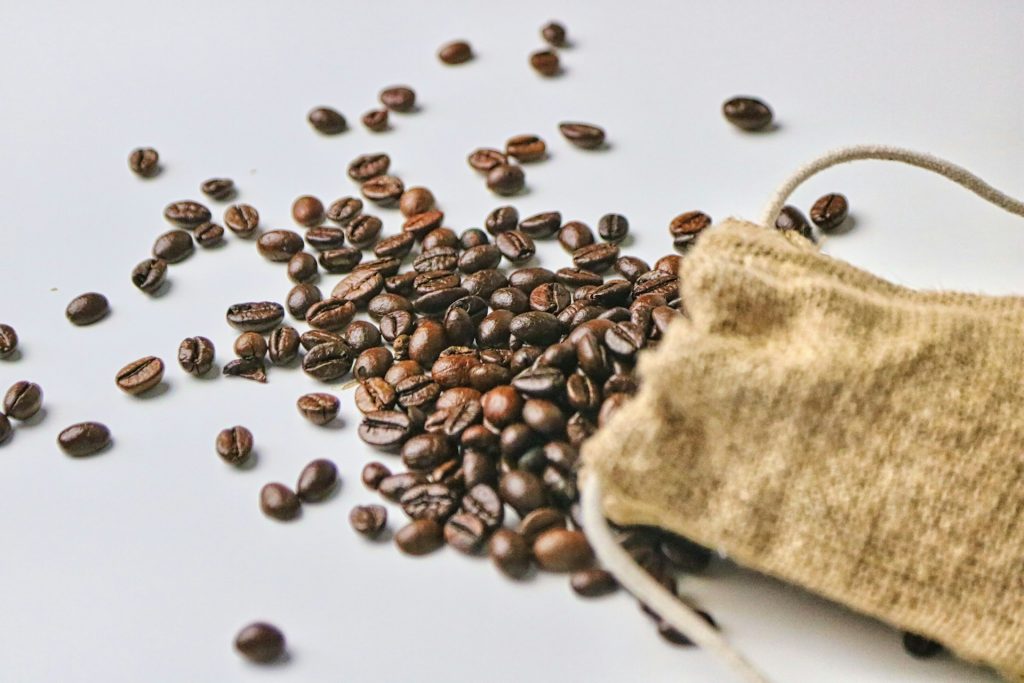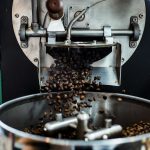Table of Contents
The journey into the heart of coffee culture often begins with a fundamental choice: medium vs dark roast coffee. Both offer a distinct palette of flavors and aromas, each with its own allure. Medium roasts bring forth a balanced symphony of taste, while dark roasts exude a profound intensity. As preferences diverge, so does the appreciation for the subtleties embedded in each cup. The decision between the two is not merely about choosing a beverage but about discovering an intimate experience with every sip.
The Art of Roasting: Medium vs Dark
The debate over dark roast and medium roast coffee hinges on personal preference. Each roast level reveals a unique flavor profile and characteristics that appeal to varied palates. At Portfolio Coffee, the celebration of this diversity is paramount, acknowledging that every individual’s taste shapes their coffee journey.
Roasting Techniques Unveiled
Roasting coffee beans is an intricate process that demands precision and skill. The initial stage of roasting begins with the roaster charging the green coffee into a heated environment. Here, the beans start to absorb heat, gradually undergoing a series of chemical and physical changes. As the beans roast, they emit a ‘first crack’, an audible signal indicating that the light roasts are developing.
Moving past this stage, the beans expand and release gases akin to popcorn popping. The roaster must be most vigilant during this crucial period between the first and second crack. The flavor of the coffee evolves rapidly, and decisions made in these fleeting moments can significantly alter the final profile of the roasts.
The Chemical Transformations
The process of roasting coffee beans is a transformative journey, where green, unassuming seeds metamorphose into rich, aromatic beans. This transformation is governed by a series of chemical reactions that reshape the bean’s structure and unlock the potential within. As heat is applied, sugars caramelize, and complex compounds form, leading to the diverse flavor notes that define medium and dark roasts.
In medium roasts, the chemical changes result in a balanced blend of the bean’s intrinsic flavors and the new qualities created during roasting. Dark roasted coffee, on the other hand, undergoes further chemical evolution, resulting in a fuller body and more pronounced roasted characteristics. The roaster’s mastery in navigating these chemical transformations is what culminates in a coffee’s unique identity.

Profiling Medium Roast Coffee
Medium roasts occupy a sweet spot in the spectrum of coffee flavors. These roasts start where light roasts end, post-first crack, and cease just before the second crack commences. The resulting medium roasts highlight the coffee’s natural flavors with a balanced acidity, offering a harmonious taste that is neither too bright nor too dark.
Flavor Nuances
The art of roasting medium-roast coffee beans is about striking a perfect balance. The flavor nuances of medium roasts are carefully crafted, teasing out the delicate interplay between the coffee’s inherent taste and the gentle caramelization from roasting. These roasts offer a complexity that can range from fruity to nutty, each sip revealing layers of subtle taste.
Medium roasts are often preferred for their versatility, providing a canvas that showcases the coffee bean’s original flavor profile while enhancing it with just the right amount of roasting influence. The goal is to create a cup that is rich and satisfying yet still allows the unique characteristics of the coffee to shine through.
Aroma Complexity
Medium roasts entice with their lively and complex aromas that can span the spectrum from citrus to berries. These scents are the prelude to the flavor narrative, setting the stage for a balanced and layered coffee experience. The aroma complexity in medium roasts is a testament to the careful roasting process that preserves the bean’s natural fragrance while introducing new dimensions.
On the other hand, dark roasts offer a different aromatic journey. The scents are robust and toasty, evoking a sense of warmth and comfort. Dark roasts carry a smoky allure, reminiscent of a cozy evening by the fireplace. The distinction in aroma between medium and dark roasts speaks to the diversity of experiences coffee can provide.
Delving into Dark Roast Coffee
Dark roast coffee takes us deeper into the realm of intense flavors and rich aromas. These roasts challenge the senses with their boldness and the promise of a coffee experience rooted in strength and character.
Intense Flavor Profile
Dark roast coffees are renowned for their intense flavor profile. Specialty coffee roasters employ a roast style that amplifies the natural qualities of single-origin coffees, highlighting the depth and richness distinctive to dark roasts. Each bean, each batch, represents a meticulous approach to achieving a taste that lingers and satisfies.
The journey with dark roasts is one of discovery, where each cup invites exploration into the myriad of darker flavors that emerge from the roasting process. Notes of dark chocolate, caramel, and a boldness that defines the dark roast experience are just the beginning of what these coffees have to offer.
Aromas of a Darker Shade
Dark roasts are characterized by their potent, smoky aromas that can transform an ordinary morning into an indulgent escape. The olfactory experience of dark roasts is a rich tapestry of scents, ranging from the deep warmth of toasted bread to the subtle hints of chocolate and spice.
The aromas of dark roasts are not just fragrances; they are an integral part of the coffee’s narrative, deepening the connection between the drinker and the brew. They lay the groundwork for the robust, full-bodied flavor that has become synonymous with dark roasted coffee.
Medium vs Dark Roast Coffee: Which Packs More Punch?
In the quest to uncover which roast level packs more punch, coffee drinkers often find themselves navigating between the light roast coffees known as “city roast” or “American roast” and the more intense dark roasts. Each cup of coffee offers a unique journey of discovery, with nutty undertones, balanced flavor profiles, and the rich essence of robusta coffee, contributing to an experience that is as varied as the roasting levels themselves.
Understanding Caffeine Levels
One of the most pervasive myths in the coffee world is the idea that dark roasts contain more caffeine than lighter ones. In reality, the roasting process transforms green coffee beans but does not significantly alter their caffeine content. The perception of strength is often associated with the robust flavors of dark roasts rather than actual caffeine levels.
Green coffee beans possess a certain caffeine content that remains relatively stable through the roasting process. While the dark roast’s bold flavor might suggest a higher caffeine concentration, the truth is that caffeine levels are determined more by bean type and brewing method than by the darkness of the roast.
Health Aspects: Benefits and Considerations
Dark roasts and medium roasts both present unique health benefits that add another layer of consideration for the health-conscious coffee enthusiast. Each type of roast contains compounds that can contribute positively to one’s well-being, making the choice between them a matter of personal health inclinations as much as taste preference.
Antioxidants in Medium and Dark Roasts
Medium roasts are admired for their balance of acidity and bold flavor, preserving much of the coffee’s original chlorogenic acid content, a potent antioxidant. On the other hand, dark roasted coffee, with its fuller body and extended roast time, develops unique compounds that offer different health benefits. The caffeine content remains relatively constant, but the flavor profile and antioxidant properties differ significantly between light roasts and dark roast beans.
The roasting process, particularly for dark roast beans, not only creates a bold flavor but also leads to the formation of antioxidants not present in green coffee beans. These compounds that emerge from the coffee beans that are roasted can contribute to overall health, offering more than just a satisfying cup but also a potentially beneficial addition to one’s diet.
The Impact on Digestion and Health
The health benefits of coffee are often celebrated, and variations in roast levels, such as medium vs dark roast, may influence these benefits. Medium roasts tend to retain more of the original characteristics of the coffee bean, which includes a rich array of antioxidants. These compounds are known for their potential in reducing oxidative stress and providing protective effects against certain diseases.
Dark roasts, on the other hand, undergo a more intense roasting process that may reduce some of these antioxidants but can lead to the formation of other beneficial compounds. Some studies suggest that dark roast coffee may be easier on the stomach, as it produces a chemical that prevents the stomach from producing too much acid. Thus, the choice between medium and dark roasts can affect not just taste but also the health benefits and digestion.

Matching Roasts to Brewing Methods
Selecting the right roast for a specific brewing method can greatly enhance the coffee experience. The optimal roast can vary depending on whether the coffee is prepared as an espresso, French press, pour-over, or cold brew.
Ideal Roasts for Espresso and French Press
Espresso and French Press are two methods that often benefit from the rich, full-bodied character of darker roasts. The espresso method, which involves high pressure and heat, extracts the deep, chocolatey flavors of dark roasts, providing a robust base for espresso-based beverages. The oily nature of darker roasts also helps create the signature crema atop an espresso shot.
For French Press, a brewing method that allows the coffee oils and fine particles to remain in the cup, medium to darker roasts are ideal. They contribute to the creamy mouthfeel and complex flavors desired in a French Press brew. Darker roasts can offer a bold taste that stands up to the method’s full extraction process, resulting in a satisfying cup.
Choosing the Best Roast for Cold Brew and Pour Over
When it comes to cold brew, the extended brewing time at low temperatures extracts different nuances from the coffee. Light roasted coffee, known for its fruity and floral notes, can produce a refreshing beverage perfect for warm days. The slow extraction process of cold brew methods highlights the subtle flavors inherent in light-roasted coffee, creating a smooth and vibrant drink.
In contrast, pour-over is a brew method that benefits from the precise control over brewing variables. Here, medium roasts often shine, as the pour-over method can highlight their balanced flavor profile and brighter acidity. However, the selection of roast should ultimately align with personal preference, as each roast level can offer a distinct and enjoyable experience.
Cultivating Your Coffee Palate
Developing a refined coffee palate involves exploring the diverse realm of coffee, from light to dark roasts, each offering unique flavor profiles and sensory experiences.
Navigating Taste Profiles
Medium roasts often boast a balance between acidity and body, allowing the coffee’s inherent flavors to shine through without the dominance of roast character. These roasts can reveal chocolatey, nutty, or fruity notes depending on the bean’s origin; as the roast progresses towards the darkest roasts, the flavor compounds transform, resulting in a cup with boldness and less acidity, often accompanied by smoky or spicy undertones.
The darkest roasts, such as French or Italian roasts, are characterized by a pronounced roast flavor, which can sometimes mask the bean’s original characteristics. However, this intense profile is preferred in many espresso blends, allowing the coffee to maintain its presence when combined with milk or water in drinks like lattes or Americanos. Navigating these taste profiles is key to understanding and enjoying the full spectrum of coffee flavors.
Learning Through Tasting
Tasting is an essential practice for anyone looking to deepen their appreciation for coffee. It involves sampling a variety of roasts and noting the distinct flavors, aromas, and mouthfeels associated with each. This hands-on experience allows one to discern the subtle differences between roasts and develop a preference for certain profiles.
Learning through tasting also includes understanding how flavors can change with different brewing methods. For instance, a coffee that exhibits bright acidity like espresso might reveal sweet caramel notes when brewed as a pour-over. By actively tasting and experimenting, individuals can expand their coffee knowledge and find their ideal cup.
The Rich World of Roasts: Final Thoughts and Recommendations
As connoisseurs explore the rich world of roasts, they will find that each roast offers its unique symphony of flavors and aromas. Lighter roasts carry the essence of their origin, with light roast beans preserving more of the bean’s particular characteristics derived from its growing conditions. These beans, often reaching a light city roast level, showcase a brown color without reaching the second crack, a testament to the Maillard reaction that develops during roasting. This chemical dance is less pronounced in lighter roasts, allowing the coffee bean’s inherent qualities to shine.
Final recommendations lean towards matching the roast with both the brewing method and personal taste. While darker roasts may lend themselves to the boldness of espresso, lighter roasts are often favored for methods like pour-over, which highlight their clarity and crispness. Whether one prefers the subtle, nuanced flavors of a medium roast or the robust, smoky notes of a dark roast, the journey through the world of coffee is endlessly rewarding. Embracing the diversity of roasts will not only enhance one’s palate but also deepen one’s appreciation for the art and science of coffee roasting.

I’m Audrey, a dedicated mother of teenagers with an insatiable love for coffee. On BeanBrewLove.com, I intertwine my need for caffeine with reflections on life. Whether expressing a nostalgic sentiment or injecting a hint of sarcasm, my blog is a reservoir of coffee culture, brewing techniques, and global coffee reviews.


